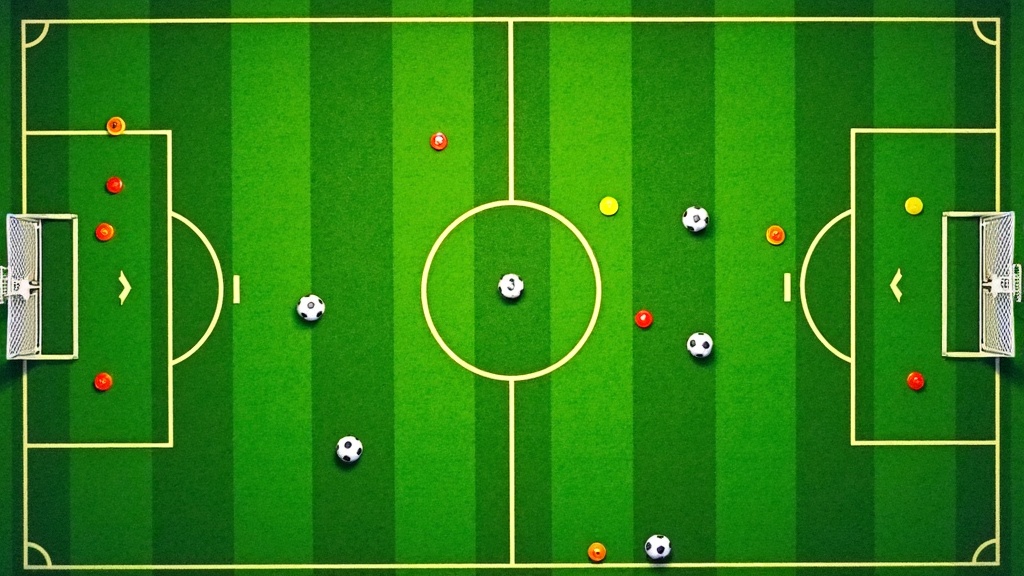Starting out as a soccer coach can feel a little overwhelming, especially with so much information floating around. When I first looked for beginnerfriendly resources, I quickly realized how helpful clear, downloadable guides could be. Soccer coaching PDFs break the game down into simple steps and provide drills, practice routines, and planning tools that are easy to use out on the field or while prepping at home. I’m sharing my top picks and insights into practical resources, so you can hit the ground running and make your coaching adventure much smoother.

Why Soccer Coaching PDFs Are Super Useful for Beginners
Printed guides and manuals have always had a place in coaching. PDFs take this further by being accessible from your phone, tablet, or computer, wherever you go. They make coaching prep flexible, whether you’re on the sideline, at home, or traveling to a match. For beginner coaches, PDFs can be game-changers because they:
- Offer ready to use session plans: Coaching PDFs usually include sessions broken down by age group and focus area, so you don’t have to invent drills from scratch.
- Break down fundamental skills: You’ll find guides on passing, dribbling, shooting, and defending; skills every beginner team needs to nail down.
- Include easy to follow diagrams: Clear visuals matter, especially when you’re still learning the terminology and layout of the game.
- Save time on planning: Having a set of PDFs means less stress thinking about what to do in your next practice, helping you focus on working with your players instead.
PDFs can also be printed out for quick reference. I love having a practice sheet tucked in my pocket; makes running drills out on the field way less stressful.
Downloadable Must-Have Soccer Coaching PDFs for Beginners
There’s a wide range of soccer PDFs out there, but I’ve narrowed down the types that I find most helpful for starting coaches. These options cover the basics but also allow a bit of creativity as your confidence grows.
- Sample Practice Plans: Complete structures for 60 or 90 minute sessions, covering warmups, main drills, and cooldowns.
- Position and Formation Guides: These help you understand common formations and what’s expected of each player on the field.
- Technical Drill Collections: Sets of core drills grouped by skill (passing, dribbling, defending) that are super easy for younger or new players.
- Game Day Checklists: Quick reference sheets for equipment, lineups, and reminders before each match.
- Parent and Player Handouts: Great for clear communication with families about team policies, how to prep for games, and general soccer rules.
You can find a huge library of coaching PDFs and readymade plans at SoccerTutor.com. I’m a big fan of resources that get right to the practical stuff, and this is a great place to start if you want quality guides.
How Soccer Coaching PDFs Make Sessions Run Smoother
Once you add these PDFs to your toolkit, you’ll notice your sessions become more organized pretty quickly. When I first started, I’d show up worried I’d forget a drill or mess up my timings, but having a printed session plan took that weight off. Here’s what makes these PDFs especially helpful:
- Consistency: When you follow a structured plan, players know what to expect and start learning more each week.
- Adaptability: If kids are restless or a drill’s not working, it’s easy to swap to a backup exercise. No need to wing it.
- Simplicity: Good diagrams and bullet points help you teach even when you’re still learning the moves yourself.
- Confidence: Having a guide means you feel less like you’re improvising and more like you’re actually coaching.
Some of the best PDFs even include space for your own notes or tips, so tracking what works and what doesn’t becomes second nature. As you move forward, these notes will help you quickly spot patterns in what your team enjoys or needs to improve on, letting you shape future practices more easily. They also serve as a great starting point for planning seasonal goals and highlighting player growth over time.
Types of Soccer Coaching PDFs Worth Checking Out
The soccer world is full of options, but not all PDFs are created equal. These are the categories of resources I’ve depended on and recommend for the smoothest start possible:
Session Planners
Session planners map out entire practices, starting with warmups and ending with a fun scrimmage. They show how long to spend on each part, which keeps things moving and avoids dead time. I use session plans to keep everyone focused, even when a drill goes a bit off course. Plus, most session planners let you customize drills or adjust timings, making each practice feel fresh.
Technical Skills Sheets
These PDFs are all about the basics, how to pass, dribble, receive, and defend. They break down each skill step by step, often using pictures or stick figures, and give quick pointers on what to look for or fix if something isn’t working. Super handy for teaching something new or when you need a drill for a small group. These sheets sometimes have troubleshooting tips, so if a player struggles with a movement, you’ll have quick fixes ready.
Formations and Tactics Guides
When coaching youth or new teams, understanding basic formations (like 4-4-2 or 3-2-1) and player positions is a must. Formation guides explain who goes where, what their jobs are, and include little graphics that make it all really clear. There’s no guessing what a “left back” or “holding mid” is supposed to do. Tactics guides may throw in strategic tips on defending as a unit or starting an attack from the back.
Checklists and Equipment Guides
Game day checklist PDFs are my favorite lastminute resource. They often come prefilled with common equipment, and you just tick off what you need: cones, extra water, pennies, match balls, and even player snacks. This cuts down on frantic equipment hunts before kickoff. Some checklists even remind you about first aid kits or paperwork, which often gets forgotten in the shuffle.
Communication Templates
Some PDFs make communication with parents and players smooth. Try parent welcome letters or a code of conduct handout; makes expectations super clear and can avoid awkward conversations later. Templates are handy for sending quick updates, game reminders, or policy changes.
Things That Trip Up New Soccer Coaches, And How PDFs Help
- Drill Confusion: It happens to the best of us; kids get lost, or you forget the next step. Diagrams and plain language instructions in a PDF keep everyone on track.
- Time Management: Practices can run long or stall out. A PDF with suggested timings helps keep everything sharp and upbeat.
- Explaining Formations: Younger players (and sometimes coaches) get confused about where to stand. Formation PDFs solve this with simple visuals.
- Parent Questions: New teams come with lots of questions from parents. Handouts you can send by email or print out really help set boundaries and routines.
Practical Example: Using a Session Plan PDF
When I tried out my first official session plan PDF, things changed quickly. With a stopwatch and a copy in my pocket, I just followed along from warmup to cooldown. Not only did the kids seem more engaged, but I also finished practice on time, which was a huge win. The session felt less chaotic, and I had time after to chat with parents, instead of packing up in a hurry. It also freed up some mental space so I could focus on individual player progress and team morale, instead of scrambling to remember the next drill.
Tips for Making the Most of Your Coaching PDFs
- Review before practice: Check over the plan, highlight parts you’re unsure about, and look up any tricky drills ahead of time.
- Keep extra copies: Bring a few printouts; things get lost or muddy on the field more often than I expected.
- Add personal notes: Write what worked, what didn’t, and quick reminders for next time. Some PDFs even leave space for this.
- Adapt as you go: Treat each PDF as a starting point. Adjust based on how your group responds so that practices are challenging but not overwhelming.
- Ask for feedback: Occasionally, ask your team what drills they like best or where they struggle. You can then tweak your plans or hunt down PDFs that fit those needs.
Where to Find the Best Soccer Coaching PDFs
SoccerTutor.com is a solid place to start, offering lots of beginnerfriendly downloads that cover various age groups and topics. Other options include major soccer associations, free online coaching forums, and local club websites. Stick to resources that update regularly, because coaching styles and player needs do change. You might also stumble upon PDFs by connecting with other coaches or joining coaching groups on social media, where files and ideas get shared often and are super up to date.
Check out SoccerTutor.com’s beginner coaching PDFs and plans here →
Frequently Asked Questions
What should every beginner soccer coach bring to practice?
Answer: Bring your printed session plan, cones, soccer balls, pennies, a whistle, and a water bottle. I always recommend extra balls and cones just in case you have more players or drills run longer than planned.
How long should beginner sessions be?
Answer: Most beginner sessions last 60 to 90 minutes. Short, focused practice beats trying to fit too much in a single day. PDFs with timing suggestions help you stick to this and keep kids engaged.
Do I really need a new session plan for every practice?
Answer: Not always. Rotating core drills helps, but mixing things up every couple of sessions keeps players challenged and interested. Many PDFs offer a sequence of progressing plans to make this really easy.
Where can I find more free soccer drills for kids?
Answer: Besides PDF resources at SoccerTutor.com, check out your community’s soccer clubs, official league websites, and online coaching forums. Many experienced coaches share their favorite drills and practice tips for free, offering up creative ideas you might not stumble upon otherwise.
Wrapping up: Soccer coaching PDFs are some of the best tools you can bring to your early coaching adventure. They organize your plans, provide quick fixes, and help you teach soccer basics without stress. As you grow, these resources can keep stepping up your confidence and your team’s progress every season.
